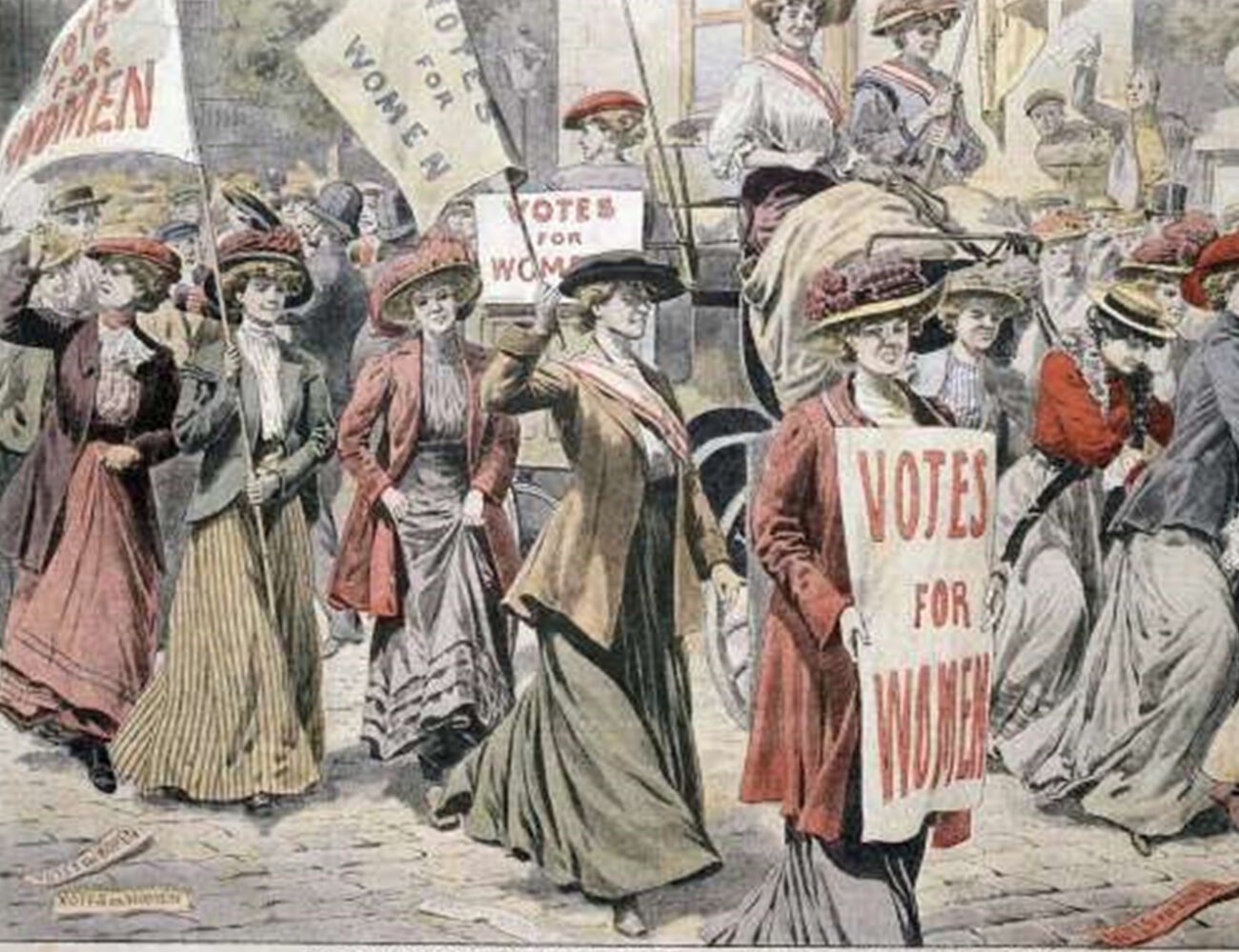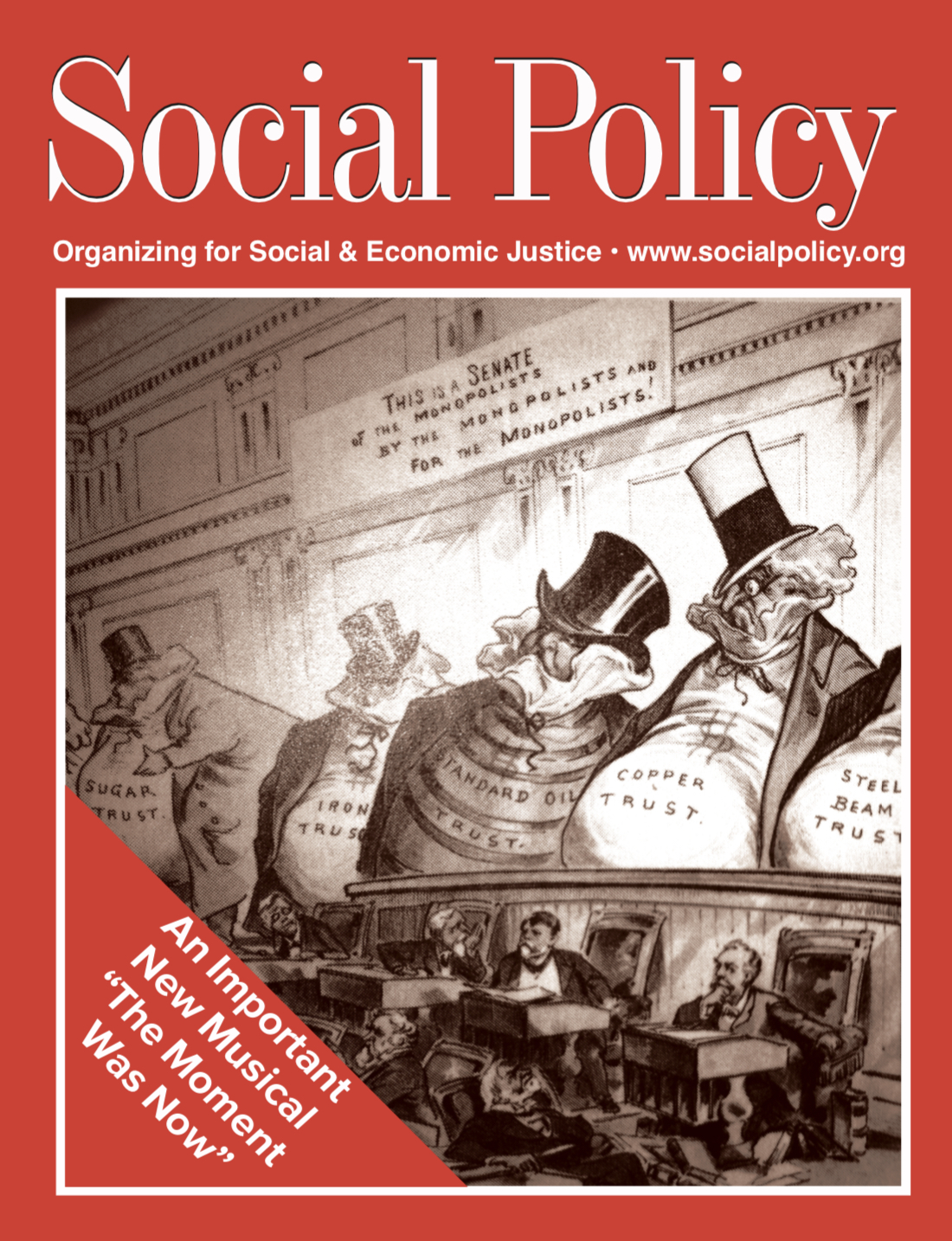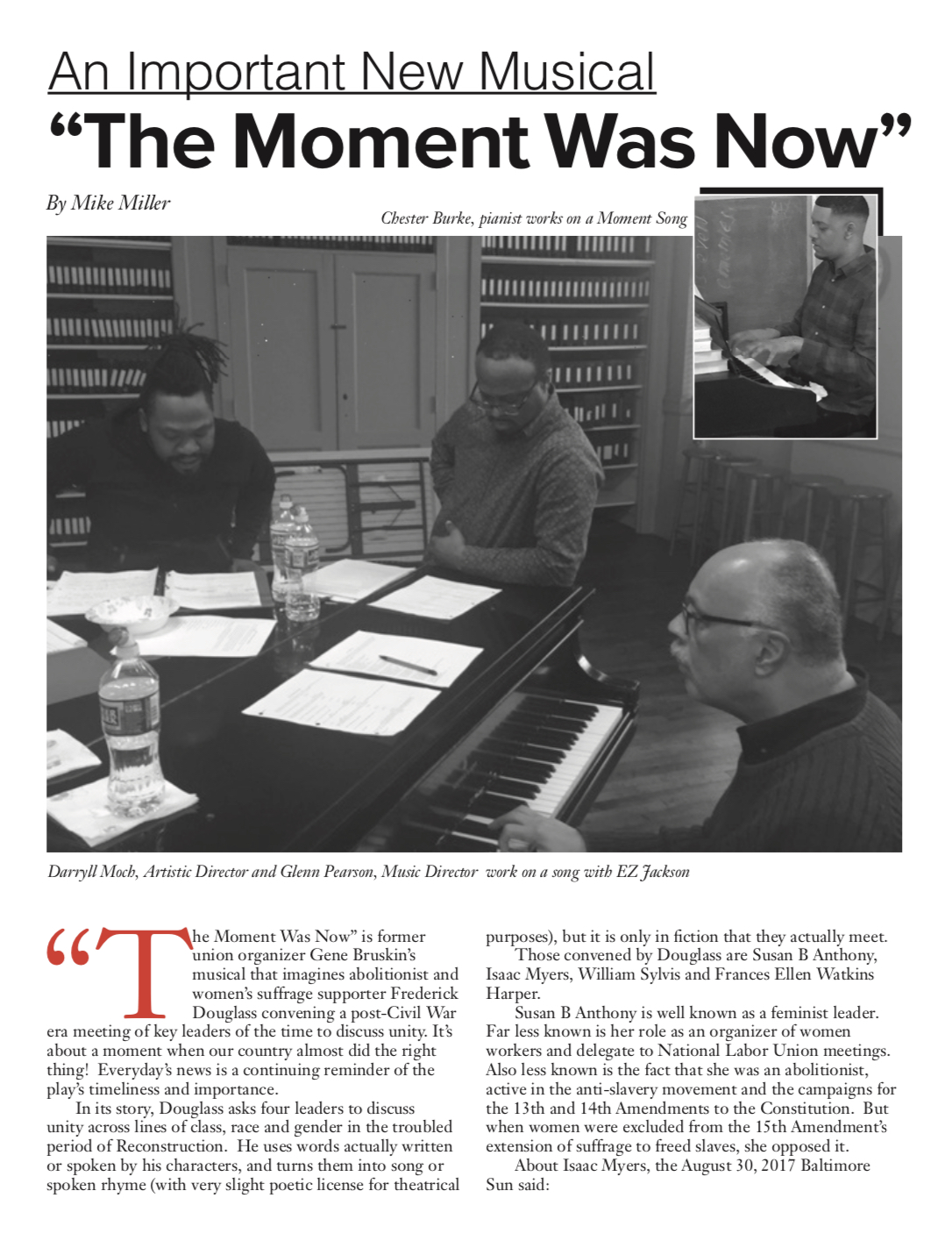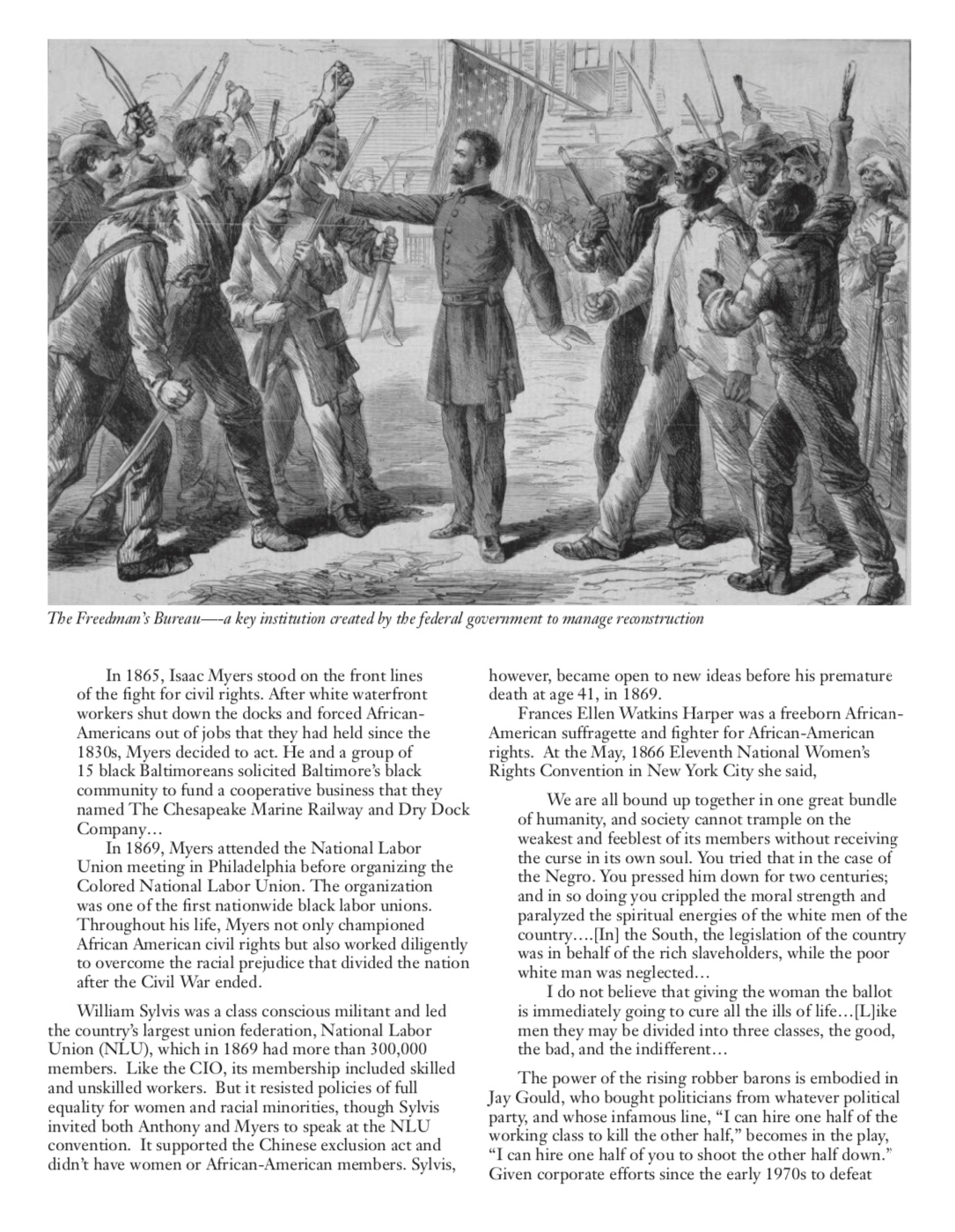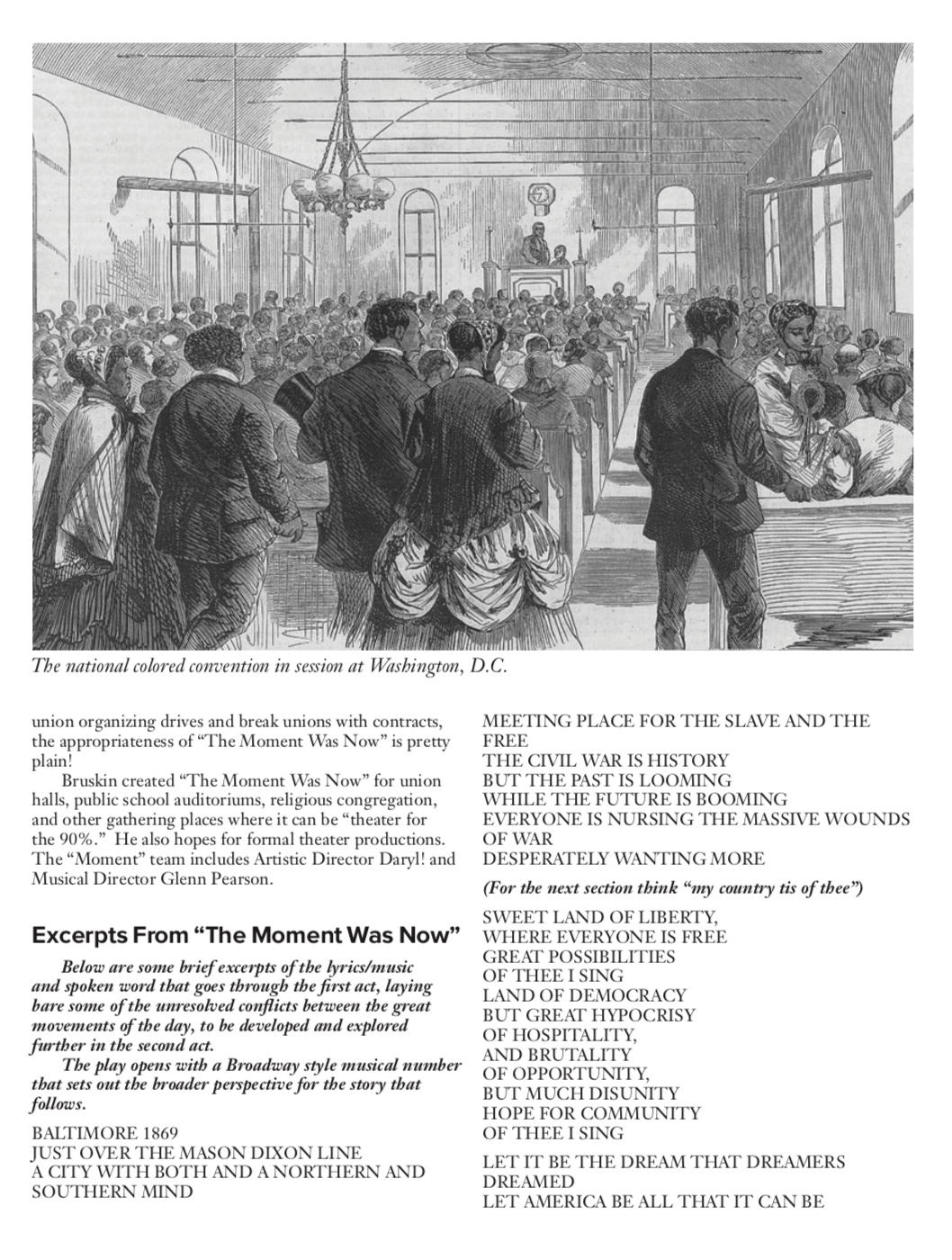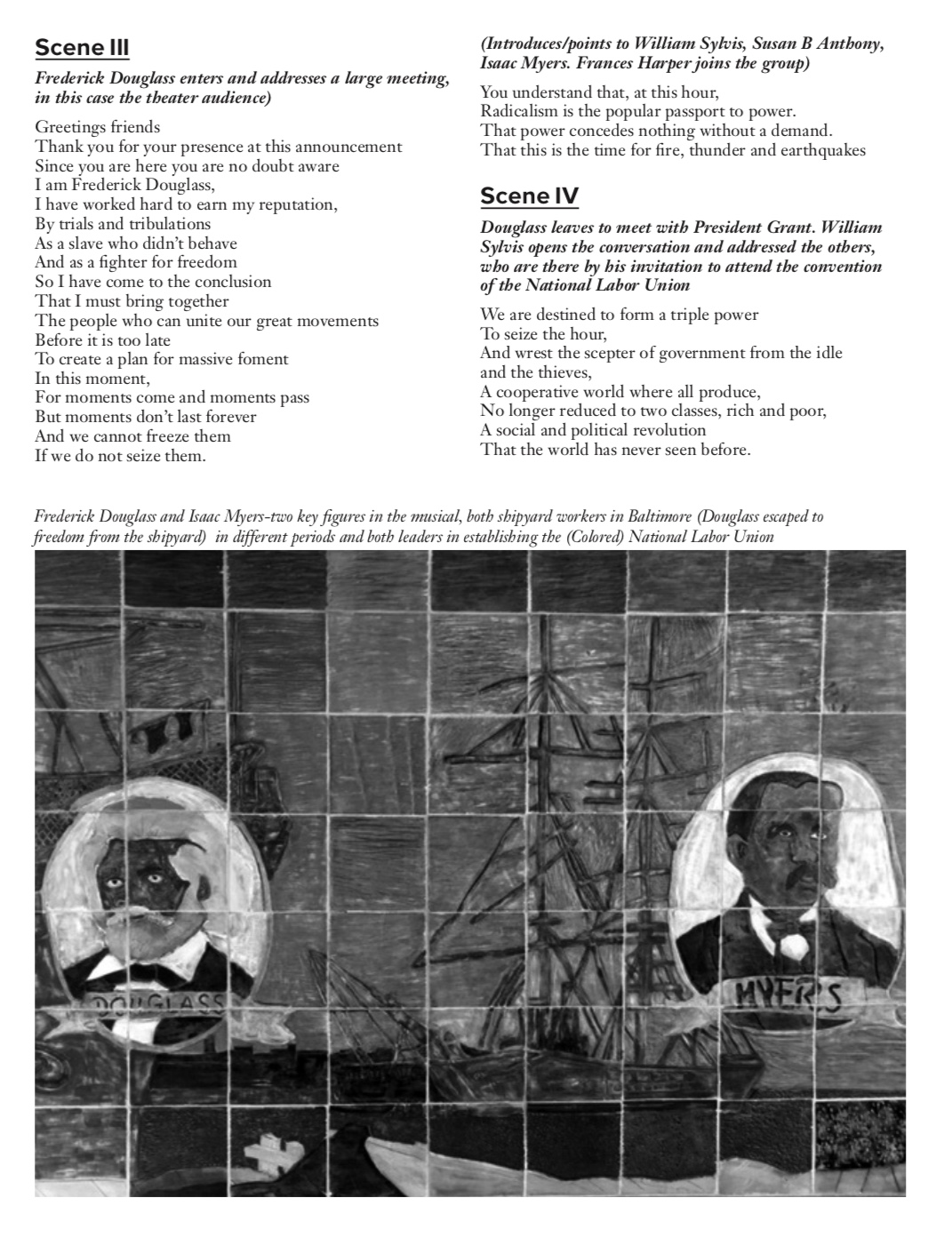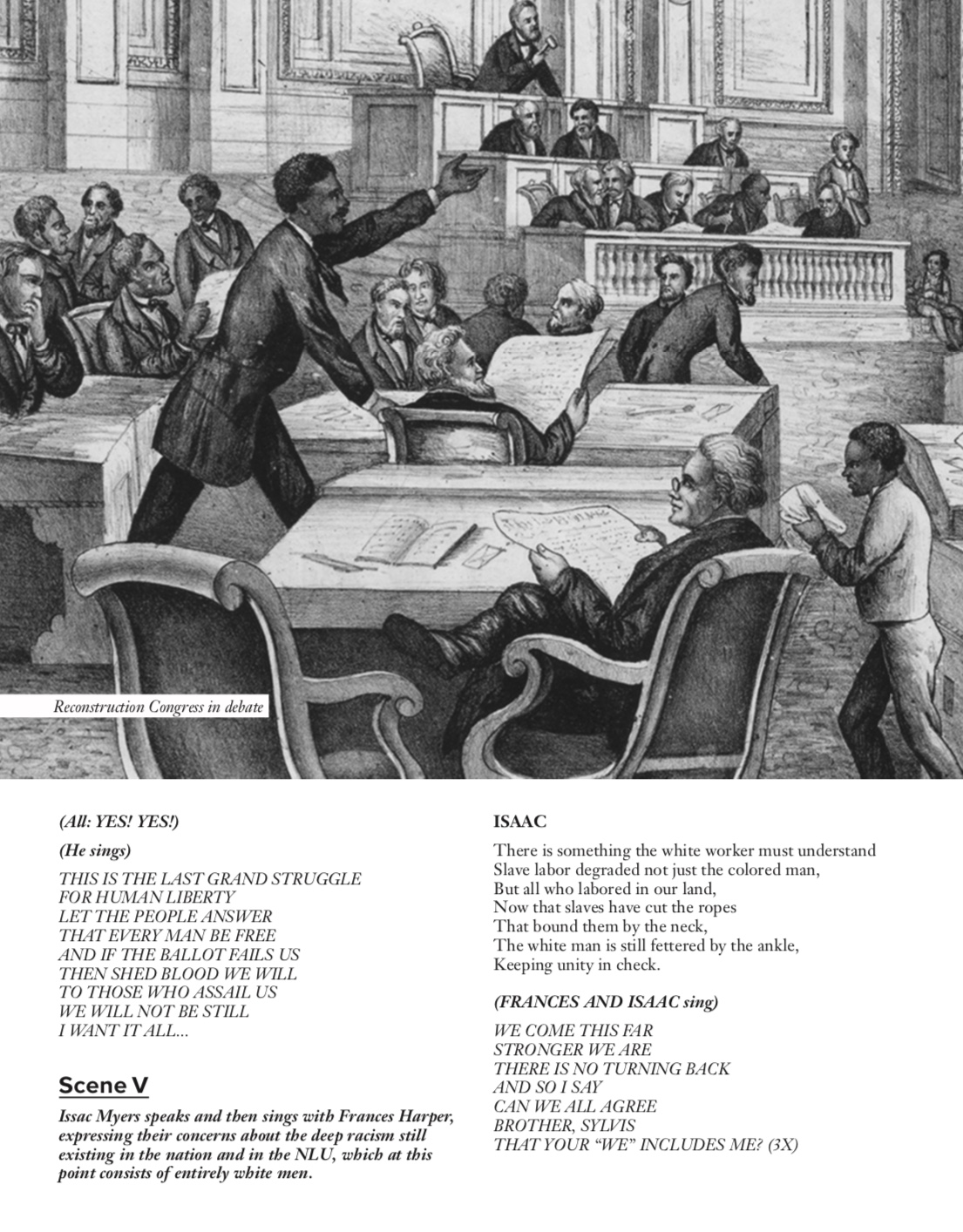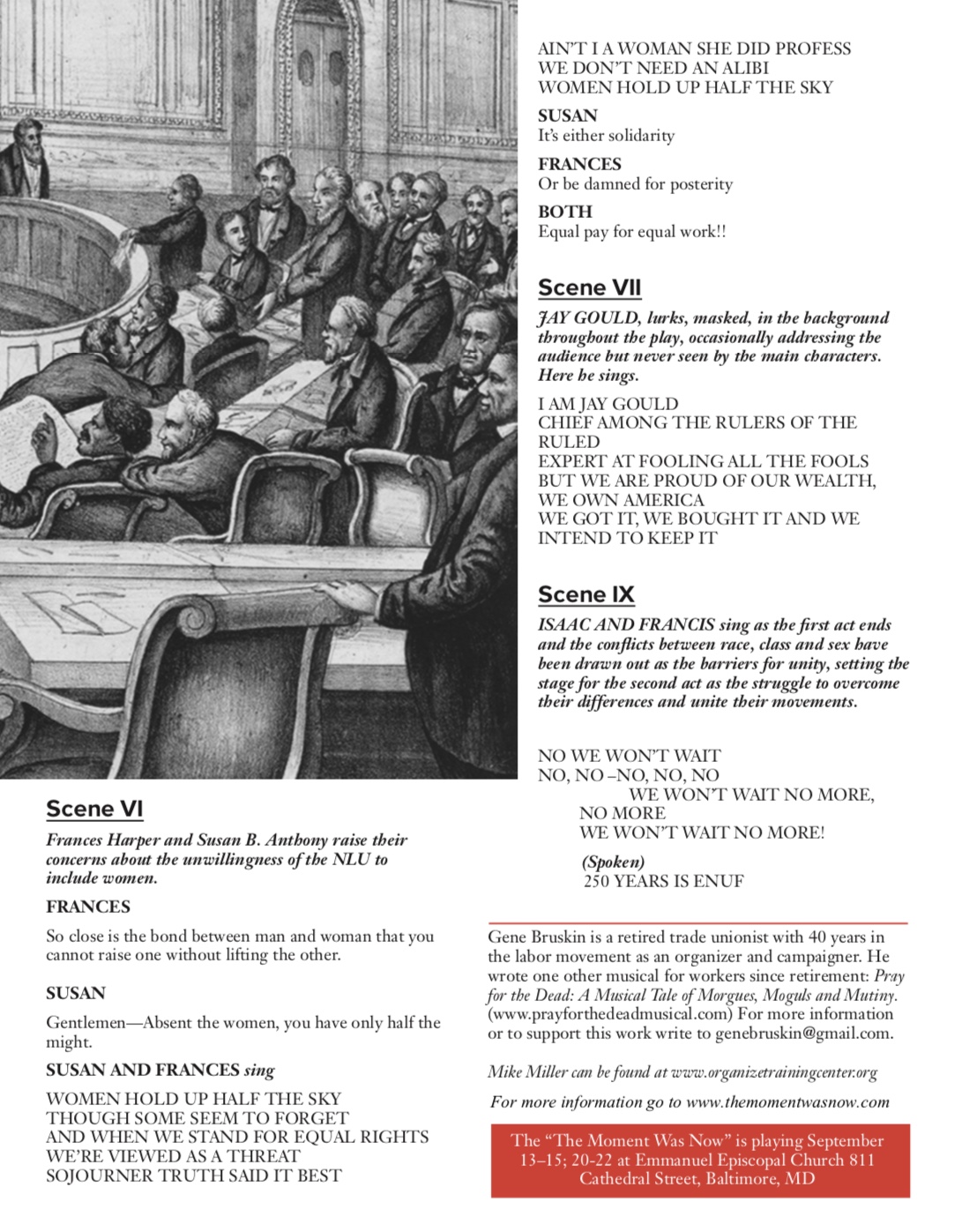Reviews & Media
New Baltimore musical imagines what happens when Frederick Douglass meets Susan B. Anthony
By Chris Kaltenbach, Baltimore Sun, Sept 11, 2019
At a time when the labor movement is at a crossroads and social justice gains appear in jeopardy, a group of prominent figures in both areas are meeting in Baltimore to take stock of what is happening and debate the best ways to move forward.
That this is happening some 150 years ago, and the meeting is only taking place thanks to the fertile imagination of a Maryland-based playwright whose “The Moment Was Now” is having its world premiere in Baltimore this weekend, doesn’t make the issues any less relevant. Gene Bruskin, a veteran labor leader and second-time playwright, insists the parallels are real, and the issues as pressing as ever.
“We’re at this moment right now,” Bruskin says, sitting down for an interview at Emmanuel Episcopal Church, where the play will be performed Sept. 13-15 and 20-22, “where this whole issue of white supremacy, of what’s the nature of the women’s movement, of the struggle among the unions for credibility — it just seems like these issues, which were bubbling up then in a way no one imagined, are bubbling up again now.” Read more
Billed as “A musical moment when America almost did the right thing,” Bruskin’s musical play centers on an imagined meeting called by abolitionist Frederick Douglass; gathered together, on the eve of the 1869 National Labor Union (NLU) Convention in Baltimore, are women’s suffrage activist Susan B. Anthony, NLU President William Sylvis, African-American labor leader Isaac Myers (he and Douglass are celebrated at Fells Point’s Frederick Douglass- Isaac Myers Maritime Museum) and author and women’s rights advocate Frances Harper.
The timing of the meeting is essential, Bruskin says. The Civil War had ended just four years earlier. It was the era of Reconstruction, when the rights of the newly freed slaves were still being debated and the promise of a color-blind U.S. seemed within reach. The labor movement was making gains, though its most active years still lay ahead. And sexual equality was becoming an increasing bone of contention, as women like Anthony sought to share in some of the gains that were seen being made by African-Americans.
“These incredible openings had developed in all areas of life, as a result of the freeing of the slaves,” Bruskin says. “This was a key transformational moment in U.S. history. It unleashed all this energy. The Industrial Revolution was about to roll out big-time — the labor movement had some 300,000 members by 1869.”
Gene Bruskin, playwright and union organizer, discusses the world premiere of "The Moment Was Now," presented by Cultural Worker Ensemble at Emmanuel Lutheran Church on Sept. 13 - 15, and 20 - 22. (BALTIMORE SUN STAFF / Baltimore Sun)
Bruskin says he took some of his inspiration from the musical “Hamilton,” and its success in using contemporary music styles and a multi-racial cast to foster a sense of inclusiveness and engage a new generation of audiences. In hopes that “The Moment Was Now” will attract audiences who wouldn’t normally attend live theater, he’s keeping ticket prices down, charging a flat $30.
“I thought, ‘Let’s bring people to this play who would never go to a play,'” he says. “I wanted to make sure that those audiences came, and that we’re gonna have conversations afterwards, I want to see, can you educate and entertain with live theater?”
D.C.-based actor and singer Julia Nixon, who plays Baltimore native Harper, believes Bruskin’s play will get a reaction from audiences. “Gene writes really compelling and provocative stuff, it got my attention immediately," says Nixon, whose resume includes a stint in the Broadway production of “Dreamgirls.” “He has some really interesting things in there, and I think his approach probably makes it palatable. It’s hard-hitting, in a lot of ways.”
Director Darryl Moch, who plays Myers, welcomed the opportunity to be part of a play that touches on so many perennial hot-button issues. “That idea appealed to me in this play, I wanted to be able to put that onstage as a director and as a performer," he says. "It could be a wonderful statement, to put all of those movements together and to try and have a conversation. My hope is that this might inspire people that see it to say, ‘You know, there’s an idea...’
It shouldn’t come as a spoiler to say that passions at the meeting depicted in the play run high, but little is resolved. Or to note that those issues of equality and opportunity are still being debated a century-and-a-half later. Which is one reason Bruskin, 73, who lives in Silver Spring and spent more than 40 years in the labor movement as an organizer and activist, is planning for post-play discussions after each performance. The idea, he says, is to speak out in the open, maybe open up a dialogue and shed light on some issues that need to be discussed. Regardless of the century.
“It’s very hard, in a diverse group, to have conversations about racism, sexism — for people to have a chance to really talk about how outraged they are to be mistreated as a worker," says Bruskin. "That is going to be the conversation, to have chances for people to talk about that stuff, for maybe a black worker to be able to stand up and talk about how the play relates to his life — and maybe his white buddy is sitting next to him, and they’ve never had that conversation.”
The Moment Was Now
Special to the AFRO, by Rafael Alvarez
“The question is … who is to be included in your dream of the future?
Isaac Myers, “The Moment Was Now”
Late on a Sunday afternoon, the voices of Frederick Douglass and Isaac Meyers boomed inside an empty hall at Emmanuel Episcopal Church in Mount Vernon. The long-dead Black heroes were brought to life by actors rehearsing for a musical that imagines the good that might have happened during Reconstruction.
Myers, a Baltimore-born Black trade unionist, is portrayed by Darryl! Moch, who directs the play, The great Douglass, who escaped slavery while working with Myers in a shipyard on the Fells Point waterfront, is played by LeCount R. Holmes Jr.
Set in 1869 Baltimore and written by retired labor organizer Gene Bruskin, the play opens with Douglass calling a meeting of historical figures ranging from Susan B. Anthony to the poet, abolitionist and Black suffragette Frances Harper, played by acclaimed jazz chanteuse Julia Nixon.
The conflict centers on an especially thorny, post-Civil War question: When it comes to winning basic human rights, is half a loaf better than none? Do some folks get to make a giant leap forward while others are left to fight another day?
A memorable refrain in the play’s songbook is, “Does your we include me?”
At the contentious meeting of like-minded souls, the arguments sail across the stage in song, echoing struggles for basic rights that persist to this day.
That’s what the conversations with the audience have been, [not the past, but] about the situation today,” said Holmes, who played Douglass when the musical had its debut in Baltimore over the 2019 Labor Day holiday. “That means this play could go around the world.”
The debate is especially poignant this year — the 150 anniversary since the 15th Amendment gave the right to vote to African-American males and a century since that same right was afforded to women.
“Isaac very clearly was the person with the larger vision,” said Moch, who like many, did not know of the somewhat obscure Myers before joining the production. “In his labor movement [pitted against White mobs hijacking Black shipyard jobs] he included folks of color and white people.”
Left out of the final accounting — and none too pleased by the prospect — were women of all colors, who had to wait another half-century before accessing the ballot box. The injustice led to acrimony between longtime friends Douglass and Anthony, a dispute rarely mentioned in school books.
Says Anthony at one point in the production: “I will cut off my right arm to stop the Negro male from getting the ballot” before women.”
Susan B. Anthony died with both of her arms in 1906, 14 years before women were given the right to vote.
https://www.afro.com/the-moment-was-now/
February 10, 2020
Darryl! Moch as Isaac Myers. (Photo by Sean Scheidt)
LeCount R. Holmes, Jr. as Frederick Douglass. (Photo by Macon Street Books)
The meeting that takes place within the show is an imagined one between four historical figures, and inspired by another — Frederick Douglass. What if Susan B. Anthony, Frances Ellen Watkins Harper, William Sylvis, and Isaac Myers had come together in 1869 in Baltimore to establish a strong movement of solidarity against industrial and railroad barons such as Jay Gould.Read More
Unlike the folk ballads of Woody Guthrie, Pete Seeger and Joan Baez, the music in The Moment Was Now is inspired by blues, R&B, rap, and even opera. Musical director Glenn Pearson, along with assistant musical director Chester Burke, headed a small but powerful music ensemble that elevated the whole show.
The show is ably directed by Darryl LC Moch, who also portrays Isaac Myers, an African-American trade union leader and caulker from Baltimore.
The power of the singers – especially Julia Nixon and Jenna Rose Stein – are what I found most remarkable about this musical. Nixon and Stein, in their respective solos, would have brought down the house even if it were not full of AFL-CIO and AFSCME members, which it was on the night that I attended. Ariel Jacobson as Sylvis and LeCount R. Holmes Jr. as Douglass completed the cast of talented professional vocalists
Stein, of Ashburn, Va., portrayed Susan B. Anthony. Women gained the right to vote ridiculously late in our nation’s history – I always knew that. But I am fortunate to have had that right all my life, so I needed Stein’s strong soprano to feel the injustice and impatience during her solo, “Women Hold Up Half the Sky.”
Nixon, of Washington, DC, was in the original Broadway production of Dreamgirls, and in this show portrayed Frances Ellen Watkins Harper, an African-American feminist we should all learn more about. Nixon’s solo, “Ain’t I a Woman,” is based on the speech by freed slave Sojourner Truth to the Women’s Convention of 1851. It is a stirring song worthy of a diva in a blues club, and Nixon has performed it in just that setting. I plan to look for an opportunity to hear her perform at Mr. Henry’s in DC.
You’d expect a heavy dose of righteousness in this musical, especially if you have learned by reading an interview with Bruskin that he has spent most of his adult life as a labor organizer. But the righteousness feels right.
The past-tense verb in the title refers to 1869 Baltimore during the post-Civil War Reconstruction, and the “Now” reminds the audience that even today, when different identity groups try to come together as a progressive movement, it isn’t easy to unite
Making “The Moment” Now
By Gwen McKinney, THE WASHINGTON INFORMER, October 12, 2019
The year was 1869. Ruins of the Civil War are being swallowed in the swirl of Reconstruction. Federal troops protecting the union victory and the newly emancipated slaves have not yet withdrawn from the South. The promise of America in the dawn of the industrial era is tangible.
Our story opens in Baltimore with Frederick Douglass (LeCount R. Holmes Jr.) calling a meeting of key players to envision a new, free, democratic nation. Pioneering Black trade unionist Isaac Myers (Darryl! LC Moch), organizing Black shipyard workers in Baltimore and across the country, is joined by Irish-Catholic labor leader William Sylvis (Ariel Jacobson). He had a vision of taking on the barons and plantation owners on behalf of poor laborers in the north and south. Susan B. Anthony (Jenna Rose Stein), considered the “Mother of Suffrage” was included to inject her militant view of women’s equality through voting rights.b
Moments after Douglass leaves the three to their deliberations, an uninvited figure emerges from the dark. She mounts the stairs. Frances Ellen Watkins Harper (Julia Nixon) takes center stage. Acknowledging she was excluded, she affirms, “They need me to make this right.” Read More,
For the next two hours, rights, wrongs, race and justice are fused into a foot-tapping, hand-clapping kaleidoscope of spoken word/rap, jazz, blues, gospel and musical theater, animated in a lyrical montage through the lens of history.
The story takes wings and soars.
The meeting in Baltimore was imagined. But the characters were real. Their expressions came from actual speeches of that era. The musical opened and closed with poetry from Langston Hughes’ “Let America Be America Again.”
A troupe of classically trained actors, set developers and musicians turned out 15 musical interventions with provocative themes complemented by 170 overhead slides flashing archival footnotes and images.
The performance enjoyed an air of authentically in the Emmanuel Episcopal Church (built in 1854) auditorium in downtown Baltimore. Seven performances, over two weekends Sept. 13-22, left most patrons wanting more.
Creator Gene Bruskin, a 73-year-old retired labor strategist, coined the show as “Theater for the 99 percent.” Estimating the production took about two years from conception to staging, he says the themes festered within him for decades, inspired by the hopes and challenges of the Reconstruction era. This was crystallized by W.E.B. Du Bois’ Black Reconstruction. It projected the possibilities and agency of that period that disintegrated into the plunder of white supremacy, labor exploitation, solidification of wealthy landowners and division among the have nots and their best interests.
“That was a moment when this nation had the chance to almost do the right thing,” Bruskin said. “But like then, the moment is still now.”
He insisted that 2019 is a perfect backdrop to revisit the possibilities. Many key events have catalyzed new awareness including the fomenting of White supremacy; heightened conversation about reparations; 400 years since the arrival of the first kidnapped Africans; 150 years since the 15th Amendment giving Black men voting rights and a century since passage of the 19th Amendment for women’s voting rights.
“Moments come and moments pass. But you cannot freeze them if you do not seize them,” recited Bruskin from his script.
The performance has generated requests for a touring show to labor conventions, civic groups, public schools and other venues where history and politics can find a marriage. A film stream is also being planned on www.TheMomentWasNow.com.
When Julia Meets Frances
When Broadway actress Julia Nixon met poet, abolitionist, suffragist Frances Ellen Watkins Harper, she felt certain she had unlocked a treasure box.
“My first thought was that this woman was a fictitious character,” Nixon said. “My second thought, when I realized she actually existed, was OMG!”
From there, she would take a journey through poetry, history and the lived experience in the footsteps of a woman revered as “the Mother of Black American literature.”
Nixon, a recording artist with a long-running stint at the popular D.C. supper club Mr. Henry’s, recently completed a two-week run of the musical “The Moment Was Now.” She confides that “living in Frances Harper’s skin” gave her new inspiration about Black women’s power then and now.
Staged in Baltimore at the historic Emmanuel Episcopal Church, “The Moment” takes us back to 1869. Harper was one of five historical characters featured in the show, which also included orator Frederick Douglass (LeCount R. Holmes Jr.) and suffrage leader Susan B. Anthony (Jenna Rose Stein).
The two-hour musical was a potent slice of American history, shining a light on hypocrisy, democracy and possibilities that confronted the country in the late 19th century. Reconstruction, women’s voting rights, the industrial revolution, labor rights and true emancipation of Black people were on the table.
But the big story embedded in the play explores suffrage, race and power — a complex and intractable conundrum that haunts us today.
As the nation marks the 100th anniversary of the 19th Amendment giving women voting rights next August, the lessons of Frances Harper and a cadre of Black suffragists of the 19th and early 20th centuries are a reminder of the schism between White feminism and Black liberation.
Harper, like many of her contemporaries, was an ardent advocate of universal suffrage. It was inseparable from abolition of slavery and full emancipation of all people beyond the act of voting.
Through a rousing performance in “The Moment,” Julia Nixon demonstrates Harper’s connection with Anthony’s cause (“I’m A Woman”) and the split when Black suffragists throw down the gauntlet with Black men, granted voting rights through adoption of the 15th Amendment (“Not a Straw in the Way”).
Harper (1825-1911) lived a full and productive life. The first known Black woman to publish a short story (“Two Offers,” 1859), her poetry collections have been republished hundreds of times. Harper joined with other Black women including Harriet Tubman and Ida B. Wells to establish the National Association of Colored Women’s Clubs in 1896. That organization, which rarely gets the recognition it deserves, was the forerunner of the NAACP.
Songstress Nixon, herself a poet and playwright, enjoyed a four-year run on Broadway after the departure of Jennifer Holiday, playing Effie in “Dreamgirls.” Her four-octave range equips her with the acumen to traverse musical genres including jazz, gospel, blues urban funk and musical theater.
“This conversation takes me back to the late 1960s and early 1970 in Robinson County, North Carolina,” Nixon reflects. “I was part of the first wave of Black children to integrate the all-white schools in our town. I knew racial hostility firsthand.”
Acknowledging that her experience pales in comparison to the journey of the post-slavery period captured in “The Moment Was Now,” Nixon said, “All I can say is thank you, Frances. You woke me up.”
“The Moment Was Now” Needs Wheels!
By Peter Olney
The Stansbury Forum
I was lucky enough to be in Baltimore, Maryland on September 13 for the opening of Gene Bruskin’s new musical play, “The Moment Was Now”. Maryland Council 3 of the American Federation of State County and Municipal Employees (AFSCME) had bought the house at Emmanuel Church on Cathedral Avenue where the play debuted for two weekends. This old staid Episcopal chapel built in 1854 was filled with a toe tapping, largely African American audience, members of AFSCME. The Moment’s message of the struggle for racial solidarity based on recognizing difference and fighting inequality was a great anti-dote to the President’s recent disgusting attacks on Baltimore. It felt good to be there and share in Bruskin’s triumph. I had previously interviewed Gene about his latest work here on the Stansbury Forum
But I have to confess that when I check out the work of a dear friend and comrade who ventures into the arts of writing or drama, I have a certain amount of trepidation. What if I don’t like the work? What do I say given my high respect for their work as an organizer and agitator? I have known Bruskin since Boston in the 70’s when he was organizing bus drivers during the Busing crisis. I know of his work in labor organizing at the giant Smithfield packing plant in Tar Heel North Carolina and as one of the co-conveners of US Labor Against the War (USLAW) after the Bush invasion of Iraq. He could have retired quietly with those signature achievements and ruminated on a sunny beach in Florida. Not Gene Bruskin. I read and saw his first musical play, “Pray for the Dead” about morgue workers who organize. It was humorous and entertaining. But “The Moment Was Now” is in another league, humorous, entertaining, inspiring but oh so topical and, as it name suggests, a perfect political fit for the moment and Trump’s presidency
It is 1869 during reconstruction in Baltimore. Frederick Douglas convenes a fictional meeting of four historical figures who all have real links to that city:
William Sylvis – The white leader of the National Labor Union (NLU)
Isaac Myers (also spelled Meyers) – Black leader of a black shipyard workers union in Baltimore and founder of a National Labor Union for people of color.
Frances Ellen Watkins Harper – a Black woman and prominent abolitionist and suffragette who was a poet and the first published Black woman novelist.
Susan B. Anthony – Famous suffragette and abolitionist.
The drama unfolds as these four figures discuss, in rhyming verse taken from their actual written remarks and in powerful song, the prospects for multiracial unity and gender equality. It is noted that while William Sylvis himself supports multi-racial unity and equality his National Labor Union has excluded black people from their convention. Susan B. Anthony supports equal rights for black people but because women are excluded from suffrage she opposes the 15th Amendment. Hovering over all these discussions is the menacing figure of Jay Gould the robber baron who is played skillfully by LeCount Holmes in a giant paper mache mask. Holmes also portrays Frederick Douglas.
The musical numbers are catchy with lyrics that don’t fade. “I Want it All”, “Does Your We Include Me?” and “Women Hold Up Half the Sky!” are three of the most memorable. So memorable that a union railroad worker told Bruskin in the aftermath of the second nights’ production that he attended with his wife that, “My wife won’t let me forget that “women hold up half the sky” I have been hearing it from her ever since we saw your play.”
All the actors are excellent, but the show stealer is Julia Nixon who portrays Frances Harper. A couple of her numbers are adventures in the power of Black gospel with her range and stage presence just knocking those numbers out of the proverbial park.
Bruskin is daring to take a form that is often culturally foreign to the working class and use it to convey a powerful political message. This is “Hamilton” with left politics although Lin Manuel Miranda is to be commended for his outspoken defense of Puerto Rico against the attacks and ignorance of Donald J. Trump. While the play is conceived and directed by Bruskin, it is a collaborative effort with able director and actor Darryl! LC Mooch, musical director Glenn Pearson and Chester Burke assistant musical director.
Unlike “Hamilton” Bruskin will need some help to get this play on wheels and out to venues all over the country. Bruskin is a union man who believes in paying scale to his performers and staff so this can’t be done on the cheap.Read more
The Moment Was Now is featured in this edition of the labor and community focused magazine Social Policy
Suffrage Race and Power
Gene Bruskin appeared on Bill Fletcher's radio show Arise, on WPFW, in April 2019 hosted by Gwen McKinney. Listen below for a snippet from the play.
The Play’s the Thing
https://portside.org/2019-04-20-19 https://portside.org/2019-04-20/plays-thing
Author: Peter Olney and Gene Bruskin
Peter O: Gene you have written a new musical play entitled “The Moment Was Now”, which takes place in 1869 in post civil war Baltimore. Can you give us a brief synopsis?
Gene: This was really a turning point in US history when America almost did the right thing. Under Reconstruction, instituted by Congress, the South was writing new state constitutions and African Americans were getting elected to local and national offices. Baltimore was a border state with a history of being half slave and half free. The play centers on the impassioned search for unity among dynamic leaders of powerful movements during this period. The conflicts and possibilities unfold at a fictional meeting convened by Frederick Douglass.
The echoes of the current moment are everywhere.
Peter O: William Sylvis, Susan B. Anthony, Isaac Myers and Frances Harper are your four protagonists, with Douglass sort of setting the stage. These are real historical characters. Can you tell us a little about each one of them? And how does Jay Gould fit in?
Gene: This is quite a remarkable group of people – all revolutionaries in their own way, but all with fatal flaws that become apparent in the course of the show. The conclusion of the civil war and the emergence of 4 million free African-Americans created a tremendous momentum for change, just as the civil rights movement of the 60’s in the US set the stage for the blossoming of the civil rights, women’s and gay liberation movements.
Of course Douglass is the legendary abolitionist and civil rights visionary, arguably the seminal figure of the 19th Century, along with Lincoln. Susan B Anthony is the most widely recognized among the others. She was an abolitionist, a suffragette and during this period, she began organizing women workers.
Isaac Myers organized a union of African American shipyard workers in 1866 in the same Baltimore shipyard where Douglass worked when he escaped. Myers went on with Douglass to found the [Colored] National Labor Union, which for a time had a national presence.
William Sylvis, an ironworker, organized the National Labor Union which represented several hundred thousand workers by 1869.
Frances Ellen Watkins Harper was an abolitionist, African American Feminist, teacher, and author, who spent years in the Reconstruction south.
Jay Gould, who lurks ominously in the background, was one of the early railroad kingpins who helped usher in the industrial revolution.
Peter O: Why is such a play relevant to today’s turbulent times?
Gene: This was a “moment” filled with opportunities and pitfalls, and unfortunately they were unable to build unity. They clashed around the issues of racism, sexism and class. Jay Gould, among others of his ilk, was able to take advantage of their divisions. This was a moment when the two-party system became consolidated and the white supremacy of the Klan was decisive in the retrenchment of the southern aristocracy.
We are at a moment now, again where white supremacy is central and there are massive movements from below and enormous wealth and power consolidating at the top. The two parties are in crisis. But moments come and moments go – clearly we must, as the saying goes, “seize the time.” This play has many lessons and we hope it both inspires and teaches, as well as entertains.
Peter O: Lin Manuel Miranda has achieved fame with “Hamilton”, and he has also been a strong advocate for the Puerto Rican people in the face of Trump’s attacks on the island and its inhabitants. Did his work inspire you to use the medium of a musical play?
Gene: “Hamilton” was a remarkable piece of musical theater and I have great respect for Miranda. It used spoken word, music and choreography to teach history. But it tells the story of a man who was in no way a revolutionary – in fact not even a progressive. It’s a story of the elite of that time, all slave owners. (Hamilton wasn’t personally but his wife came from a wealthy slave owning family) Although the characters are all actors of color, a statement in itself, there is barely a word about slavery. There are 46 songs but none about slavery.
After seeing the play I thought, wow, if music and spoken word can be used so powerfully to tell this somewhat traditional history, what if I used that format to tell the story of an exciting and relevant moment in history. “The Moment Was Now” is almost entirely in spoken word and musical format. After extensive research I was able to use the characters own words throughout, with some poetic license of course. These characters all knew each other but never met as a group. We have been assembling a talented group of actors and musicians with the help of my artistic director, Darryll Moch, and my music director, Glenn Pearson and it is coming to life.
Peter O: “Hamilton” has certainly been a blockbuster but is that cultural form the best way to reach labor audiences? What was your experience with your previous musical, “Pray for the Dead”?
Gene: I wrote “Pray for the Dead – a Musical Tale of Morgues, Moguls and Mutiny” in 2016 and it played for unions and community groups. People loved it because it talked about them, about class and power, with music and humor. At some shows the workers yelled out at the boss and behaved raucously during the show, more like they were in a union hall than at a theater. I loved it. “Moment” is also what I call “theater for the, 99%,” written for people who don’t normally go to theater. We are partnering with unions, women’s groups and others to fill the theater.
There is something about the immediacy of theater that is powerful and theater, particularly earlier in the 20th century, has a history in the US as a force for change. We intend to have audience discussions after each play -that worked very well with “Pray” – people want to talk about this stuff.
Successful movements need people’s culture – can you imagine the 60’s civil rights movement if there was no singing?
Peter O: You have a long and impressive 40 year plus career of labor and people’s justice organizing, why did you get the theater bug now?
Gene: I grew up in South Philly and my dad was a big fan of musicals – the records were always playing. I co-wrote some original plays for community theater in the 70s, But once I got involved in the labor movement I had to put it aside. After I retired, in addition to keeping one foot in the labor movement, I decided to give myself the gift of writing again and it’s been a great experience.
Peter O: Obviously producing such a musical play requires resources. How do you intend to get the funds necessary to produce such a musical?
Gene: That is a challenge. One other major difference between “Moment” and “Hamilton” is that our tickets will be very affordable – no $1,000 seats.
No big investors and in fact many foundations aren’t interested in so-called “political” plays. But we intend to pay our talented crew as fairly as possible. And there are many other costs involved. So we are scrambling.
Peter O: How can our readers help you to put on this important work?
Gene: The play will open in Baltimore on August 23rd and show for three weekends.
We have launched a Go Fund Me that makes it easy for folks to contribute.
They should go to: https://www.gofundme.com/the-moment-was-now
Also they can find us on Facebook at: “The Moment Was Now”
If someone wants to reach me directly they can email me at genebruskin@gmail.com
[Peter Olney is retired Organizing Director of the ILWU. He has been a labor organizer for 40 years in Massachusetts and California. He has worked for multiple unions before landing at the ILWU in 1997. For three years he was the Associate Director of the Institute for Labor and Employment at the University of California. View all posts by Peter Olney → https://stansburyforum.com/author/peter-olney]
Peter O: William Sylvis, Susan B. Anthony, Isaac Myers and Frances Harper are your four protagonists, with Douglass sort of setting the stage. These are real historical characters. Can you tell us a little about each one of them? And how does Jay Gould fit in? Read more
Gene: This is quite a remarkable group of people – all revolutionaries in their own way, but all with fatal flaws that become apparent in the course of the show. The conclusion of the civil war and the emergence of 4 million free African-Americans created a tremendous momentum for change, just as the civil rights movement of the 60’s in the US set the stage for the blossoming of the civil rights, women’s and gay liberation movements.
Of course Douglass is the legendary abolitionist and civil rights visionary, arguably the seminal figure of the 19th Century, along with Lincoln. Susan B Anthony is the most widely recognized among the others. She was an abolitionist, a suffragette and during this period, she began organizing women workers.
Isaac Myers organized a union of African American shipyard workers in 1866 in the same Baltimore shipyard where Douglass worked when he escaped. Myers went on with Douglass to found the [Colored] National Labor Union, which for a time had a national presence.
William Sylvis, an ironworker, organized the National Labor Union which represented several hundred thousand workers by 1869.
Frances Ellen Watkins Harper was an abolitionist, African American Feminist, teacher, and author, who spent years in the Reconstruction south.
Jay Gould, who lurks ominously in the background, was one of the early railroad kingpins who helped usher in the industrial revolution.
Peter O: Why is such a play relevant to today’s turbulent times?
Gene: This was a “moment” filled with opportunities and pitfalls, and unfortunately they were unable to build unity. They clashed around the issues of racism, sexism and class. Jay Gould, among others of his ilk, was able to take advantage of their divisions. This was a moment when the two-party system became consolidated and the white supremacy of the Klan was decisive in the retrenchment of the southern aristocracy.
We are at a moment now, again where white supremacy is central and there are massive movements from below and enormous wealth and power consolidating at the top. The two parties are in crisis. But moments come and moments go – clearly we must, as the saying goes, “seize the time.” This play has many lessons and we hope it both inspires and teaches, as well as entertains.
Peter O: Lin Manuel Miranda has achieved fame with “Hamilton”, and he has also been a strong advocate for the Puerto Rican people in the face of Trump’s attacks on the island and its inhabitants. Did his work inspire you to use the medium of a musical play?
Gene: “Hamilton” was a remarkable piece of musical theater and I have great respect for Miranda. It used spoken word, music and choreography to teach history. But it tells the story of a man who was in no way a revolutionary – in fact not even a progressive. It’s a story of the elite of that time, all slave owners. (Hamilton wasn’t personally but his wife came from a wealthy slave owning family) Although the characters are all actors of color, a statement in itself, there is barely a word about slavery. There are 46 songs but none about slavery.
After seeing the play I thought, wow, if music and spoken word can be used so powerfully to tell this somewhat traditional history, what if I used that format to tell the story of an exciting and relevant moment in history. “The Moment Was Now” is almost entirely in spoken word and musical format. After extensive research I was able to use the characters own words throughout, with some poetic license of course. These characters all knew each other but never met as a group. We have been assembling a talented group of actors and musicians with the help of my artistic director, Darryll Moch, and my music director, Glenn Pearson and it is coming to life.
Peter O: “Hamilton” has certainly been a blockbuster but is that cultural form the best way to reach labor audiences? What was your experience with your previous musical, “Pray for the Dead”?
Gene: I wrote “Pray for the Dead – a Musical Tale of Morgues, Moguls and Mutiny” in 2016 and it played for unions and community groups. People loved it because it talked about them, about class and power, with music and humor. At some shows the workers yelled out at the boss and behaved raucously during the show, more like they were in a union hall than at a theater. I loved it. “Moment” is also what I call “theater for the, 99%,” written for people who don’t normally go to theater. We are partnering with unions, women’s groups and others to fill the theater.
There is something about the immediacy of theater that is powerful and theater, particularly earlier in the 20th century, has a history in the US as a force for change. We intend to have audience discussions after each play -that worked very well with “Pray” – people want to talk about this stuff. Successful movements need people’s culture – can you imagine the 60’s civil rights movement if there was no singing?
Peter O: You have a long and impressive 40 year plus career of labor and people’s justice organizing, why did you get the theater bug now?
Gene: I grew up in South Philly and my dad was a big fan of musicals – the records were always playing. I co-wrote some original plays for community theater in the 70s, But once I got involved in the labor movement I had to put it aside. After I retired, in addition to keeping one foot in the labor movement, I decided to give myself the gift of writing again and it’s been a great experience.
Peter O: Obviously producing such a musical play requires resources. How do you intend to get the funds necessary to produce such a musical?
Gene: That is a challenge. One other major difference between “Moment” and “Hamilton” is that our tickets will be very affordable – no $1,000 seats.
No big investors and in fact many foundations aren’t interested in so-called “political” plays. But we intend to pay our talented crew as fairly as possible. And there are many other costs involved. So we are scrambling.
Peter O: How can our readers help you to put on this important work?
Gene: The play will open in Baltimore on August 23rd and show for three weekends.
We have launched a Go Fund Me that makes it easy for folks to contribute.
They should go to: https://www.gofundme.com/the-moment-was-now
Also they can find us on Facebook at: “The Moment Was Now”
[Peter Olney is retired Organizing Director of the ILWU. He has been a labor organizer for 40 years in Massachusetts and California. He has worked for multiple unions before landing at the ILWU in 1997. For three years he was the Associate Director of the Institute for Labor and Employment at the University of California. View all posts by Peter Olney → https://stansburyforum.com/author/peter-olney]
“The story takes wings and soars.”
Singing “Women Hold Up Half the Sky”
Actors are Julia Nixon and Jenna Stein. Photo: Sean Scheidt


